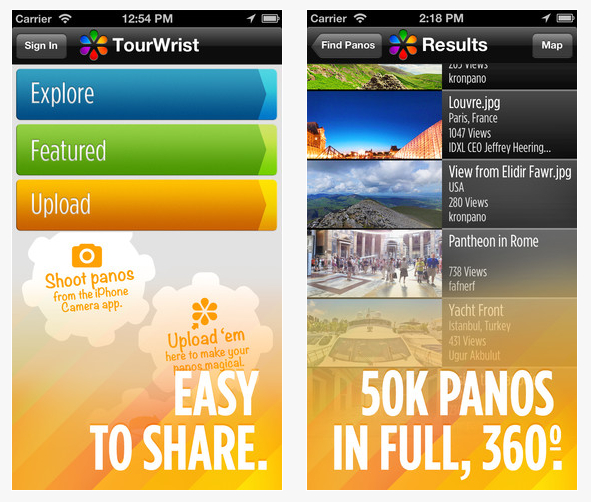TourWrist: The game-changer of 2012?
Every now and then a company comes along that looks set to be the next big thing and then as the marketing hype dies down, we’re all left feeling deflated. With its easy to use 360-degree technology, will TourWrist deliver the goods? Pamela Whitby talks to the founder, a confident man
TourWrist’s chief executive Charles Armstrong is a confident man and, it would appear, a man with vision. Defining his company as the “YouTube of virtual tours” he seems pretty certain that within the next six months the TourWrist panoramic technology will reach tens of millions of people. The industry, it seems, has bought into the vision too: TourWrist recently swept the floor with awards at a recent PhocusWright conference. “Within days….no hours of winning the award we had received enough interest from high-profile investors to complete our convertible equity certificate,” he says. With prize money and seed investment totalling $1.25 million the company, which has recently completed a commercial release of its latest image capture technology, is poised for growth. Armstrong is not able to given any clues but says there is even a significant exposure is on the horizon.
Mobile focus
So what makes TourWrist special? “We recognised about two-years ago that this technology had the ability to unite customers who are excited about locations with brands that are looking for nothing more to have exciting possibilities,” says Armstrong. YouTube has done this successful and Twitter does it to some extent as well by bridging the gap between social and personal tools with online media marketing. Panoramic videos in particular, however, hold strong potential because they allow people to record moments in time. “And this,” says Armstrong, “lets other people make more informed confident decisions about the places they want to go, the things they want to buy.”
However, when the company set about deciding how to deliver this new medium a few years ago it had to decide what the new viewing format would be. It seems the team knew even then that mobile would be the future – hence the name. “You tour with your wrist using a mobile device, you are a tourist,” says Armstrong. Undoubtedly, the name TourWrist is a clever play on words which neatly encapsulates the firm’s offering.
Focusing its energies on a mobile format was the right move. According to Google 47% of all travel plans today start on a mobile device and that number is only going to get bigger.
Virtual tours have been around for a long time but the medium has been complicated. “Before technologies like TourWrist you needed to have a DSLR camera and a panoramic tripod mount and an eight millimetre fish eye lens and stitching software and time and patience and money,” says Armstrong. While TourWrist isn’t alone in being able to provide a panoramic technology tool, Armstrong strongly believes it is the easiest to use and the most accepting “because we will take everybody else’s content, allowing you to upload any panoramic video in the world”. TourWrist, he says, aims to tap into this “magic little window that developers can use as easily to embed panoramas as they can to embed photos or videos”. This, Armstrong says, is what is going to change the game.

It was this that was approach that was the secret to YouTube’s success; they allowed you to use any device to shoot a video and then easily upload it. Once it is there content can be easily embedded from any device and that is exactly the model TourWrist is looking to mirror. However, the technology is actually quite complicated, far more so that photo or video.
Still it is worth the effort as it stands to yield the most enjoyment because it is the only medium that offers an uncurated, uncropped view. If a customer is able to tour a property using this technology, it is possible to build a much higher level of confidence quite quickly.
In fact studies have shown that travellers are 67% more likely to book a hotel room when a virtual tour is offered and the average session link online will jump from three to 20 minutes. “That is pretty profound,” says Armstrong.
Two-pronged approach
The model is both B2C and B2B which people often find hard to grasp. “Whenever I get that disbelief I point them towards YouTube [which is powerful tool for both businesses, strong ecosystem for business and consumers],” he says.
On the consumer side, TourWrist will debuting a set of 25 premium features that you can upgrade to for a monthly subscription fee. “By offering these services to a small but measurable percentage of our existing install base we believe we can reach a profitable threshold quickly,” he says. From a business perspective we want to get into as many handsets on the street as possible. “If we drive new traffic to a travel brand’s website that originated from our app or tools then we collect and industry standard affiliate booking commission,” Armstrong explains. He is confident that by using this technology, OTAs, hotels and so on will see measurable impact to their bottom line.
But TourWrist is also something of a destination for consumers and businesses; in the past 45 days it has seen 2.5million unique visitors to its own site.
“We have set up a business model a product set that appears to be successfully appealing to the right market and now we want to get into as many hands as possible,” says Armstrong. With equity commitments in place, TourWrist now has some runway...and this looks like one newcomer that may just be ready for a smooth take-off.

